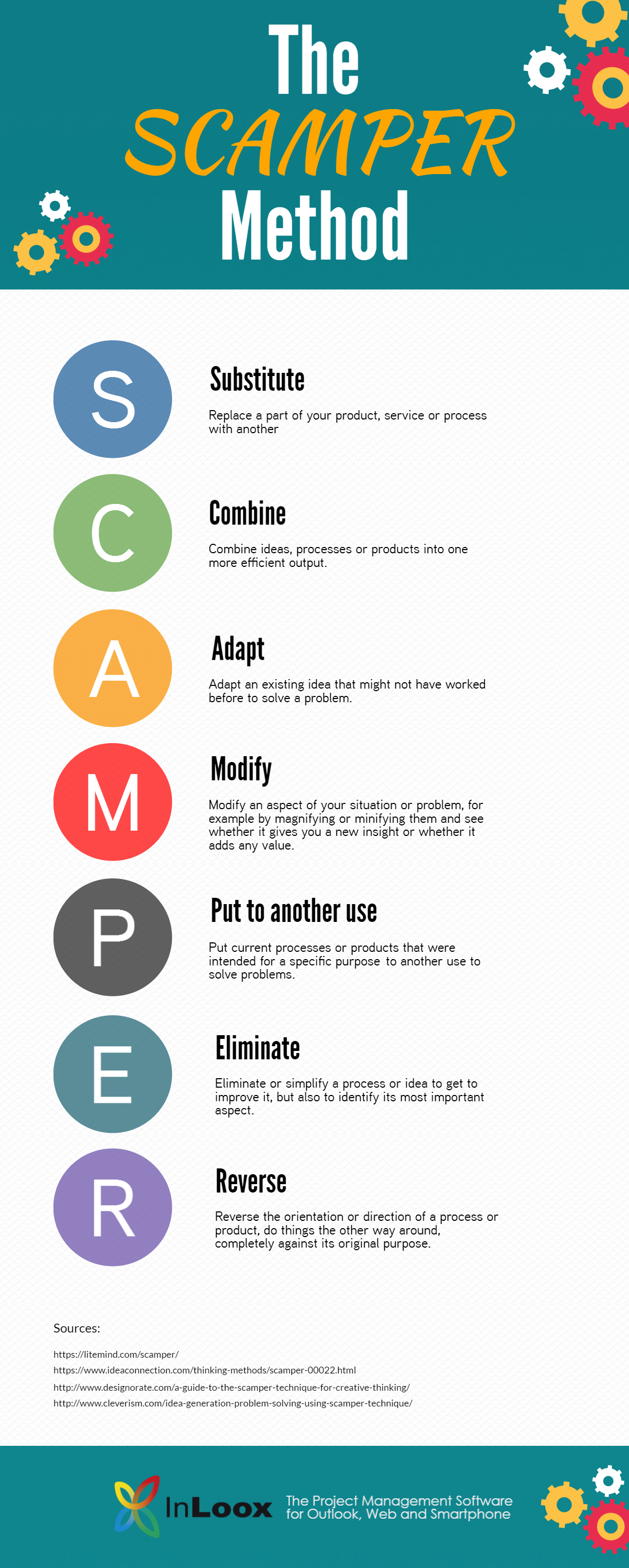There is a quote from Thomas Edison that goes “There’s a way to do it better – find it.” This is exactly what innovation is about, it’s about improving existing processes and concepts instead of creating something entirely new. You don’t have to reinvent the wheel, but you can make it run more efficient. The SCAMPER method is built on this understanding. At its core SCAMPER is an easy to implement creative thinking and problem solving method that facilitates continuous improvement.
Better Problem Solving with the SCAMPER Method
Linh Tran, Venerdì, 01 Aprile 2016 | Reading time: unknownWhat is SCAMPER?
SCAMPER is actually an acronym and each letter stands for one thinking technique: Substitute, Combine, Adapt, Modify, Put to another use, Eliminate, Reverse. So SCAMPER is a collection of these various techniques and you can choose to use one or all of the seven methods to find solutions to your problems. It’s also possible to jump from one technique to another.
The SCAMPER method is very similar to Design Thinking in that both these concepts aim to find solutions to problems. However, Design Thinking places the human factor at the center and its goal is to find creative ways to solve problems. The SCAMPER technique is more focused on the process of finding unusual and creative solutions to problems, but also to come up with innovative ideas, and the goal of improving a product or service.
The seven SCAMPER techniques
Substitute
Find a part of your concept, product, service or process etc. that you could replace with another to see whether it will result in improvements, such as efficiency gains. This will help you test which alternative works better, like a trial and error process. An example for a substitution would be an automobile manufacturer using different composites for the frame to make vehicles lighter.
Combine
Most of the time you don’t have to come up with something entirely new, but the solution(s) actually already exists. One idea might not work alone, but you could combine several ideas, processes or products into one more efficient output. A great example for a combination of two different products are cell phones with an integrated camera.
Adapt
As mentioned above, you probably already have the right solution to your problem, you just don’t know it yet. Sometimes an idea that worked to solve one problem, could also be used to solve a different problem. An example for the successful adaption to a new situation is Netflix. The company started out in 1999 as a DVD rent service, but unlike Blockbuster they quickly realized that the future belongs to online streaming and changed their business model. Netflix is now a serious competitor to traditional TV networks, while Blockbuster went out of business in 2013.
Modify
Modify an aspect of your situation or problem, for example by magnifying, i.e. exaggerating, them and see whether it gives you a new insight or whether it adds any value. This will help you identify which part of your process or concept is the most significant. An example for magnifying an aspect would be an organization deciding to expand the production of one product and focusing on that product.
Put to another use
This is very similar to “Adapt”, it’s about putting an existing idea or concept to another use, i.e. using it differently than it was originally intended to. An example would be using ocean waste to produce shoes or products that were invented for a whole different use than they are being used now.
Eliminate
The elimination might sound familiar to those that know about Lean or Six Sigma. It’s about eliminating inefficient processes (‘waste’) with the goal of streamlining them. An example for eliminating is Apple’s decision to not include an optical CD/DVD drive in their MacBook Air to make them thinner and lighter.
Reverse
Reverse the orientation or direction of a process or product, do things the other way around, completely against its original purpose. Sometimes when you reverse the way a product is used, it will help you see things from a different perspective. For example, an organization that has always used the top-down approach when making decisions, might find that they could improve their decision making processes by adopting a bottom-up approach.

